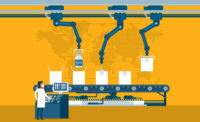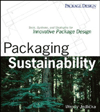Getting Ahead of the Curve with Sustainable Packaging as the Pandemic Continues

Has sustainability taken a backseat as concerns about COVID-19 continue to dominate? News cycles have shifted. Coverage of and concerns about the negative impacts that plastic and other non-sustainable items have on the environment seems to have declined a bit. People have turned to single-use items in droves — disinfecting wipes, paper masks, plastic grocery bags — things that don’t have more than one “touch point” to avoid possible virus transfer. Just as many municipalities banned things like plastic bags and straws, they are forced into a position where these kinds of products seem to be the only option acceptable to consumers.
Will this seeming disregard for sustainability continue? Our research says no. In fact, our recent data indicates that consumers are still thinking about the environment — a lot. Eighty percent of consumers believe COVID-19 stay-at-home orders have had a positive impact on the environment. Post-pandemic, they also plan to increase activities that are perceived to be beneficial to the environment.
Before the pandemic, we saw some brands already undertaking more eco-friendly packaging initiatives, trying to stay ahead of what may soon become widespread demand. Smart brands understand that, if not already, they will soon be held accountable by increased consumer demand for environmental responsibility. As shown by our study, this is not likely to change, although the timeline for certain metrics may be lengthened...
Current Purchase Decision Landscape
Depending on your pre-pandemic personal newsfeed, you may or may not have had the perception that the sustainable packaging movement is a large one. I believe there is no doubt that it will grow, no matter the current size of concern. However, in looking at consumer purchase behavior thus far, we haven’t seen many turn away from beloved brands due to packaging. We are not seeing that consumers are willing to trade down on product delivery or customer experience. An eco-friendly pack has to be an “extra” or “value-add” on top of whatever needs are currently being met by the brand.
This isn’t to say that if a consumer is considering, for example, two respected brands that they won’t pick the one with the more eco-friendly pack. In addition, brands should be aware that demand varies due to category as well. In certain categories such as food, beverage and personal care consumers are more likely to look for sustainable options. Retail channel also plays a role. Stylized packaging counts less online (i.e. Amazon) and means more for bricks and mortar display, where the package has to capture consumer attention and break through the clutter. We must also consider the massive increase in online shopping right now and whether or not this trend will continue, making in-store presentation less important.
Current Brand Packaging Landscape
In our business, many clients are not only testing eco-friendly packaging now, but they are also pursuing organizational commitments surrounding sustainability. Their future objectives in this arena are taking shape in current exploration of package design. We’re doing work with clients to explore various types of materials and see which ones resonate with consumers, asking questions like: Is the packaging noticeable? Do people recognize any eco-friendly features? Will it trigger a buy? Can the revised, eco-friendly pack still deliver on the product promise?
This kind of research shows a forward-thinking approach to avoid a consumer backlash that is coming around the corner when it comes to sustainability. Most of the top CPG companies understand that if they aren’t in the game and moving toward this goal, there could be implications down the road such as “Brand X doesn't care about the environment” or “Brand X isn't relevant to me because of their values on the environment.” As far as actual packaging changes, we have clients looking at paper, stainless steel, glass, and others. The verdict is still out on the most ideal choice and how consumers feel about it. Smart consumer feedback can help us figure out the best answers, both for consumers and for the environment.
In step with an examination of packaging choices, many brands are also boosting involvement in social action. This takes the form of initiatives such as giving back to local communities with profits or product donations like Toms or Bombas, “buy one give one” models. Many are taking things to the next level, as the amount of companies pursuing things like B-corporation status is on the rise. B-corps are verified by an independent, nonprofit third party that gauges the companies’ positive impact on workers, communities, the environment and more. All of these moves are part of rising commitment by brands to support the values that are important to their target audiences.
Consumer emotions are high, and brands are under scrutiny. People are shopping differently, but they still care about the environment and have expectations surrounding brand actions. A whopping 93% of respondents in one of our recent studies said that they are open to hearing from brands during this time. Steps taken now will determine which brands and business come out of this pandemic with a connection to their audiences, and which ones get left behind. Being eco-friendly when it comes to packaging is a competitive advantage. Soon, it will become the price of entry. Smart companies recognize this, are making moves to decrease their impact on the environment and will be communicating these moves to their target audiences when the time is right.
Looking for a reprint of this article?
From high-res PDFs to custom plaques, order your copy today!









